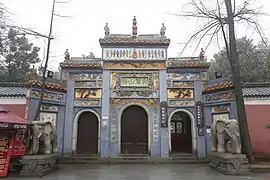Shanmen
The Shanmen (simplified Chinese: 山门; traditional Chinese: 山門; pinyin: Shānmén), also known as the Gate of Three Liberations, is the most important gate of a Chinese Chan Buddhist temple.[1]
| Shanmen | |||||||
|---|---|---|---|---|---|---|---|
 | |||||||
| Simplified Chinese | 山门 | ||||||
| Traditional Chinese | 山門 | ||||||
| Literal meaning | The Gate of Three Liberations | ||||||
| |||||||

Etymology
The origins of the name "sanmen" are debated. One theory is that "Shanmen" takes its literal meaning of "Mountain Gate", because temples were traditionally built in forested mountain areas where Chan monks could seclude away from secular life. Another suggests that during various episodes of suppression of Buddhism in Chinese history, monks moved their monasteries deep into the mountains, and later built gates at the foot of the mountain to guide pilgrims to the temples. A further theory is that "Shanmen" is a corruption of "Sanmen", or "Three Gates", referring to the "three gateways" to liberations.(三解脫門) in the Dharma - the "Kongmen" (空門; emptiness liberation), "wuxiangmen" (無相門; no-aspects liberation) and "wuyuanmen" (無愿門; desireless liberation).[2][3]
The latter view correlates with the traditional structure of Chan temples which included three gateways, said to symbolise the three gateways.
Architectural styles
.JPG.webp)
Historic Shanmens in China are either a gateway of the paifang style, or a more substantial building, typically with three archways. Where a substantial building is used, the two side gateways might be simplified to arched or circular windows, leaving only the middle gate for access. The gate building may be called the "Hall of Three Liberations" or "Hall of the Mountain Gate" (山門殿).[1]
Traditionally, if the Shanmen takes the form of a gate building, statues of two guardians of Buddhist law are erected in that hall as guardians of the entrance (identified as "Heng and Ha" (the "A-un" Nio in Japanese). This is the arrangement at Jietai Temple in Beijing.
In some Chan temples, the Shanmen building is combined with the Hall of the Four Heavenly Kings, so that the Four Heavenly Kings serve as guardians of the gateway to the monastery. In other Chan sect temples, the Shanmen building is combined with the Maitreya Hall, with a statue of the Maitreya Buddha erected in the centre of the hall. This is the arrangement seen at Shaolin Temple and Longhua Temple. Yet other Chan temples combine both the Maitreya Hall and the Hall of the Four Heavenly King with the Shanmen, so that the entrance building also features the statue of the Maitreya Buddha at the centre as well as the Four Heavenly Kings on the sides. This is the arrangement at Lingyin Temple.
References
- Zi Yan (2012-08-01). Famous Temples in China. Beijing: Time Publishing and Media Co., Ltd. p. 25. ISBN 978-7-5461-3146-7.
- Wei Ran (2012-06-01). Buddhist Buildings. Beijing: China Architecture & Building Press. ISBN 9787112142880.
- Han Xin (2006-04-01). Well-Known Temples of China. Shanghai: The Eastern Publishing Co. Ltd. ISBN 7506024772.
Further reading
| Wikimedia Commons has media related to Shanmen. |
